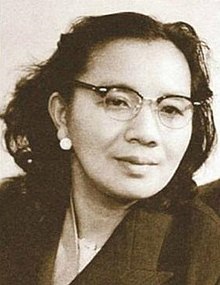Shamsiah Fakeh
Shamsiah Fakeh | |
|---|---|
 | |
| Born | 1924 Kampung Gemuruh, Kuala Pilah, Negeri Sembilan, Federated Malay States, British Malaya (now Malaysia) |
| Died | October 20, 2008 (aged 83–84) |
| Resting place | Sungai Besi Muslim Cemetery, Kuala Lumpur, Malaysia |
| Other names | Ratu Rimba (Malay for 'Queen of the Jungle') |
| Known for | Resisting the British colonial occupation during the Malayan Emergency. Leader of the Angkatan Wanita Sedar. Prominent member of the Malayan Communist Party. |
| Relatives | Jamaliah Jamaluddin (granddaughter) |
Shamsiah Fakeh (1924 – 20 October 2008) was a Malaysian nationalist and
Early life
Shamsiah was born in the village of Kampung Gemuruh near the town of
Family life
Shamsiah was married five times from the age of 17. Her first husband, Yasin Kina, abandoned her while she was pregnant with their second child and both children died in their infancy. Her second husband, J. M. Rusdi, was eventually discovered to be an informer for the Japanese forces then occupying Malaya.
She was also briefly married to Ahmad Boestamam, the leader of PKMM's youth wing, Angkatan Pemuda Insaf (Awakened Youth Organisation; API). In her memoirs, she claimed that her marriage with Boestamam broke down due to her disagreement with the latter's decision to pay a fine to avoid a jail sentence for publishing a book deemed seditious by government in 1947.[1] Notably the marriage was never mentioned in any of Boestamam's memoirs and writings.
Her fourth husband, Wahi Annuar, was a fellow CPM member who was captured by British and imprisoned. Shamsiah was told that he had surrendered and thought he was dead. He was, in fact, imprisoned for 15 years and eventually died in 1980.
Her final marriage was to another CPM member, Ibrahim Mohamad, in 1956. They remained married until his death in 2006.[4]
Political activism
Early involvement
As a fiery orator, Shamsiah was scouted by both the
Armed struggle
With the banning of the PKMM, API and AWAS in 1948 prior to the declaration of the
Exile
The couple remained in China and served as broadcasters with
As a result of faction politics within the CPM and the chaos that resulted from the
Return to Malaysia
Shamsiah and her family applied to the Malaysian government for permission to return to the country from 1985 onwards. Following the terms of the 1989 peace agreement signed between the CPM and the Government of Malaysia in
Her memoirs were first published in 2004 by
Death
Following a stroke in 1999, Shamsiah had generally been in poor health and was bedridden by 2007.[5][8] She died on 20 October 2008 at the residence of her son, Jamaluddin Ibrahim (father of Jamaliah Jamaluddin), due to respiratory failure and was buried at the Sungai Besi Muslim cemetery at 5.30pm of the same day.
Present at the funeral were some prominent politicians including the deputy president of
.Controversies
In 1981, the defected chairman of the CPM, Musa Ahmad, claimed that Shamsiah had committed infanticide by killing her third child while in the jungle to avoid capture.[9]
She subsequently denied the allegation in her memoirs and explained that she was convinced by fellow guerillas to give the child away to local villagers to be raised upon entering an unfamiliar district. It was only later that she discovered that the child had in fact been killed. The Japanese was raiding the whole village in an attempt to find her child, and threatened to behead everyone in the village if the child is found hidden by one of the villagers. There was no way to hide the crying child, so it was killed by one of the villagers by drowning, and the Japanese never found it.[1]
References
- ^ ISBN 967-942-659-9.
- ^ "Shamsiah Fakeh, the Iron Lady of the Communist Party of Malaya". BERNAMA. 21 October 2008. Retrieved 21 October 2008.
- ^ "Lebai Maadah: Controversial Reformist Scholar of the Younger Generation". Islamic Da'wah Foundation Malaysia. 29 November 2005. Retrieved 21 October 2008.
- ^ a b c "To exile and back again". The Star. 25 May 2008. Retrieved 21 October 2008.
- ^ a b "New edition of Shamsiah Fakeh's book launched". 19 November 2007. Retrieved 22 October 2008.
- ^ Martin, Vengadesan (20 October 2008). "Telling their side of history". The Star. Retrieved 25 May 2008.
- ISBN 978-983-3782-32-1.
- ^ "Veteran communist leader Shamsiah Fakeh, 84, dies". The Star. 20 October 2008. Archived from the original on 20 October 2008. Retrieved 20 October 2008.
- LCCN 81941672.
